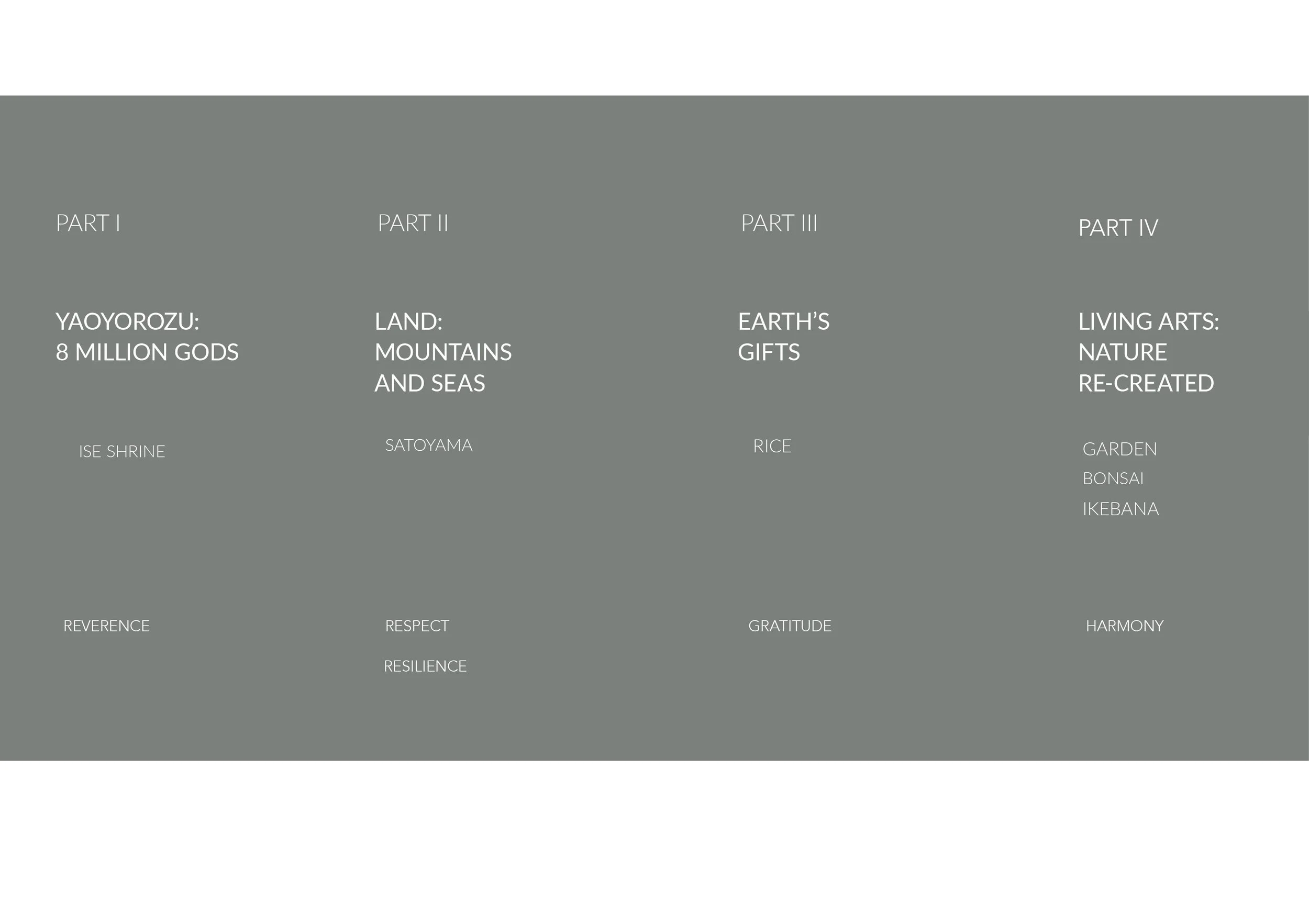SHIZEN: UNIVERSE IN A DEWDROP
The focus of my book is the intimate, deeply sensual relationship of the Japanese people with nature – the cornerstone of their spirituality.
Japan is a country of countless gods and two major religions. For more than a thousand years, the indigenous Shinto and Buddhism, which arrived from China in the 5th century, have coexisted and influenced each other. Buddhas and bodhisattvas have mingled with kami. Although most Japanese do not consider themselves “religious,” they feel connected to the myriad of divine creatures from these two realms. They experience them in a very sensual way – through nature.
In contemporary Japanese, shizen – the word usually translated into English as nature – denotes something that has no beginning and no end. Self-perpetuating and self-created, shizen embodies the divine – mysterious force that permeates life in all its expression.
It is therefore through their relationship with nature – the land, all living creatures, plants, and even some objects and phenomena – that people can partake in that sacred realm. The experience affords them a chance to sense that all beings are interconnected and that we, humans, are part of this intricate web – something bigger than ourselves.
Both Shinto and Buddhism inspire a profound appreciation of the mystical beauty and wisdom present in the natural world; both foster keen awareness of its fragility and impermanence.
My images are an attempt to convey the awe and reverence the natural world can inspire in people, to share the sense of joy and wonder, but also of respect and humility towards the intricate, infinite web of connections. I look at how the Japanese embrace nature’s rhythms and appreciate its blessings. I focus on their deeply held belief that everything in nature is filled with divine power and therefore, to use the words of the 13th-century Zen master Eihei Dogen, “speaks the truth of existence.”
PART I
8 MILLION GODS
Some claim 8 million kami exist in Japan. Seven are believed to be responsible for the creation of a single grain of rice and one, supposedly, hides in every daikon pulled from the ground. In reality, nobody is able to count because these Shinto gods are formless and invisible. Besides, there is no point in counting. Kami are many and one. Theirs is a realm inaccessible to people – sometimes said to be located in the misty world of clouds, sometimes referred to as the underworld or the world of shadows.
Yet, these gods are not distant nor removed from the world inhabited by humans. Capricious, unpredictable, they come and go as they wish. But they also feel intimately close. They perch near streams and waterfalls, they fly above impenetrable forests, lurk amid rice paddies. Kami are deeply entwined in nature, and it is through nature that the Japanese connect with them. The experience is sensual. Rather than praying, naming, explaining or counting their gods, the Japanese feel them. They sense kami’s presence, and it fills them with trepidation.
PART II
SHIMAGUNI: ISLAND COUNTRY
Japan is an archipelago of some six thousand islands straddling the Pacific Ring of Fire, one of the world’s most volatile tectonic regions. In the country besieged by natural disasters – earthquakes, volcanoes, typhoons, and tsunamis – the threat of a catastrophe is always present. In a split second, dwellings can be obliterated, crops destroyed, lives lost. Any form of existence is fragile and precarious.
And yet, the Japanese approach their land with fondness and affection. It sustains them. It offers refuge to all living creatures. It is a source of comfort. Vast seas and majestic mountains, rushing rivers and meandering streams, lush forests and mossy canyons are treated as physical manifestations of the divine world. People take pleasure in them; they revere them. Centuries of experience with disasters have taught them that they cannot overpower nature. Instead, with grace and humility, they strive to adapt to it.
Since times immemorial, mountains and seas in Japan have been revered as gods. People have prayed to them, believing they are the source of spiritual and life-sustaining force. Soaring high into the sky, mountains are seen as a bridge that connects people with the divine world. Closer to heaven than any other elements of the land, they are believed to be abodes of gods and ancestral spirits (it’s where souls go after death). In ancient times, most mountains were considered off-limits to humans. They inspired fear. People admired and worshiped the peaks from afar.
SATOYAMA (AND SATOUMI)
In ancient times, people did not dare climb, let alone build anything on them. They did however erect shrines and set up rice paddies at the foot of the mountains, hoping that gods might descend to earth to offer their blessing. That was the core of the satoyama – a special zone in which humans interacted with the divine world. People tended their fields there, cut grasses to fertilize soil, foraged for herbs, collected wood for fuel and construction.
Above, in the mountains, gods and ancestral spirits presided over streams, waterfalls, and rivers that carried pure water onto fields and villages below. It was this water—a sacred gift of nature and deities—that sustained life in the satoyama. Feeling reverent and grateful, people perceived themselves as stewards of their land. They cared for it. They understood its resources were limited and, therefore, managed them carefully.
PART III
NATURE’S GIFTS
RICE
For centuries, rice has been the foundation of Japan’s economy (it was used as a currency and as a form of taxation) and its most important staple. Although its consumption decreased as the country became more prosperous and more open to foreign influences, it still plays a prominent part in Japanese diet.
But rice in Japan is way more than a staple. Treated as the most sacred gift of divine spirits, it is a cornerstone of Japanese spirituality. Seven gods are believed to hide in each grain – gods of sun, cloud, soil and water provide it with nutrients; god of wind pollinates the stalks, god of insects eliminates pests and diseases. Farmers, who plant, harvest, cultivate soil and irrigate fields, are also considered gods -- they collaborate with nature, and in doing so, partake in the sacred act of creation.
Rice features prominently in Japanese festivals and rituals – from New Year’s celebrations and wedding ceremonies, to prayers for bountiful harvest or offerings made to express gratitude for successful crops. The Japanese emperor, considered to be a descendant of the sun deity Amaterasu, grows rice in the palace gardens. Along with fish, rice is the most important offering made to deities, both in Shinto shrines and Buddhist temples.
WASHOKU
Washoku is the name of traditional Japanese cuisine (和 stands for “Japan’ or ‘harmony; and’ 食 means ‘food’ or ‘eating’). It calls for the use of fresh and seasonal ingredients that come from a variety of local sources (mountains, fields, forests, oceans, rivers, etc.). It also emphasizes the need to balance different flavors (salty, sour, umami, bitter and sweet), as well as textures, and colors (green, yellow, red, white and black). It is believed that food which harmoniously combines such a variety and that appeals to all senses is bound to be healthy and nutritious.
Applauded for its “respect for nature that is closely related to the sustainable use of natural resources” Washoku has been recognized by UNESCO as the Intangible Cultural Heritage.
A typical Washoku meal, called ichi ju san sai (“one soup, three side dishes”) consists of a miso soup, accompanied by a small dish of protein (in the old days, it would typically be tofu, or seafood; today, it can also be meat) and small portions of pickled or fermented vegetables. Its centerpiece is always a bowl of plain, steamed rice, (most often without sauce, spices or adornments).
PART IV
LIVING ARTS: NATURE RE-CREATED
GARDEN | IKEBANA | BONSAI
Both Shinto and Buddhism are based on feelings and intuitions rather than well-articulated beliefs or principles. They distrust words and shun direct expression. Instead, to get closer to their gods and spirits, their followers strive to interact with nature. By creating and tending to their gardens the Japanese can partake in the sacred realm. That’s also what underscores the art of ikebana and bonsai.
It is the purpose of the Japanese gardener to bring together different worlds and realities – to connect heaven with earth, people with gods, the sacred with the mundane.
Co-existing with nature that can unfold its fury at any given moment, the Japanese learned to approach it with humility and respect. All of “nature arts” – gardening, ikebana, bonsai – fuse the awe for the powerful forces of nature with the desire to tame it — to impose some pattern,
Gardener’s task is to recognize beauty of nature and to create platform for its appreciation —
To connect the ephemeral with the eternal
Despite a great variety of styles and features, all Japanese gardens share some important qualities in common.
A) Presence of rocks and water (the latter is often abstract – symbolized by raked gravel or sand)
B) Presence of an island, often expressed symbolically (as in dry landscape gardens), alludes to the Buddhist notions of paradise. An island underscores the idea that the garden itself is a form of paradise – an isolated fragment of nature that was transformed to make it amenable to gods.
The act of care is considered a spiritual practice. Discipline is needed to refine your mind and character. Zen in particular emphasizes the importance of physical labor and believes it to be a path leading to enlightenment. By engaging in small, mundane, repetitive tasks, one can forget self, defy the flow of time. It’s a form of meditation.





